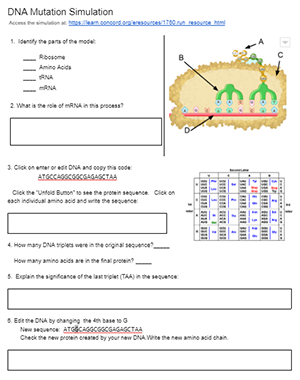
This activity uses a simulation from the Concord Consortium. It shows how DNA is transcribed to RNA and then turned into a protein. It’s a very clear animation and can be used on its own as part of a lecture on protein synthesis. I have even used this as a demonstration to show protein folding in my advanced class.
The simulation allows you to edit the DNA which will then create a new protein. Students start with a basic sequence that includes a start codon (met).
Students transcribe and then translate the sequence. The last codon is a STOP codon. This means that there are 7 triplets in the original change, but only 6 amino acids!
Students then edit the DNA in a specific way so that they can observe the effects of a point mutation, a frameshift mutation, and a silent mutation. In the point mutation, a single base is changed which leads to a difference amino acid.
You can also do this activity with the class if you have a projector, this would also allow more discussion on why some point mutations change the output protein and why some are silent.
Grade Level: 10-12
Time Required: 15-20 minutes
HS-LS1-1 Construct an explanation based on evidence for how the structure of DNA determines the structure of proteins which carry out the essential functions of life through systems of specialized cells
HS-LS3-1 Ask questions to clarify relationships about the role of DNA and chromosomes in coding the instructions for characteristic traits passed from parents to offspring.

